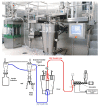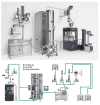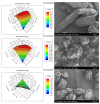Advances in Twin-Screw Granulation Processing
- PMID: 33925577
- PMCID: PMC8146340
- DOI: 10.3390/pharmaceutics13050624
Advances in Twin-Screw Granulation Processing
Abstract
Twin-screw granulation (TSG) is a pharmaceutical process that has gained increased interest from the pharmaceutical industry for its potential for the development of oral dosage forms. The technology has evolved rapidly due to the flexibility of the equipment design, the selection of the process variables and the wide range of processed materials. Most importantly, TSG offers the benefits of both batch and continuous manufacturing for pharmaceutical products, accompanied by excellent process control, high product quality which can be achieved through the implementation of Quality by Design (QbD) approaches and the integration of Process Analytical Tools (PAT). Here, we present basic concepts of the various twin-screw granulation techniques and present in detail their advantages and disadvantages. In addition, we discuss the detail of the instrumentation used for TSG and how the critical processing paraments (CPP) affect the critical quality attributes (CQA) of the produced granules. Finally, we present recent advances in TSG continuous manufacturing including the paradigms of modelling of continuous granulation process, QbD approaches coupled with PAT monitoring for granule optimization and process understanding.
Keywords: PAT tools; QbD; continuous processing; granulation mechanisms; twin-screw granulation.
Conflict of interest statement
The authors declare no conflict of interest.
Figures



















Similar articles
-
Downstream processing from melt granulation towards tablets: In-depth analysis of a continuous twin-screw melt granulation process using polymeric binders.Eur J Pharm Biopharm. 2018 Mar;124:43-54. doi: 10.1016/j.ejpb.2017.12.005. Epub 2017 Dec 14. Eur J Pharm Biopharm. 2018. PMID: 29248561
-
Metamorphosis of Twin Screw Extruder-Based Granulation Technology: Applications Focusing on Its Impact on Conventional Granulation Technology.AAPS PharmSciTech. 2021 Dec 14;23(1):24. doi: 10.1208/s12249-021-02173-w. AAPS PharmSciTech. 2021. PMID: 34907508 Free PMC article. Review.
-
Twin-screw melt granulation: Current progress and challenges.Int J Pharm. 2020 Oct 15;588:119670. doi: 10.1016/j.ijpharm.2020.119670. Epub 2020 Jul 30. Int J Pharm. 2020. PMID: 32739382 Review.
-
Continuous twin screw granulation: Impact of microcrystalline cellulose batch-to-batch variability during granulation and drying - A QbD approach.Int J Pharm X. 2021 Mar 19;3:100077. doi: 10.1016/j.ijpx.2021.100077. eCollection 2021 Dec. Int J Pharm X. 2021. PMID: 33870182 Free PMC article.
-
Continuous twin screw granulation - An advanced alternative granulation technology for use in the pharmaceutical industry.Int J Pharm. 2020 Apr 30;580:119215. doi: 10.1016/j.ijpharm.2020.119215. Epub 2020 Mar 16. Int J Pharm. 2020. PMID: 32194206 Free PMC article. Review.
Cited by
-
Design Space and Control Strategy for the Manufacturing of Wet Media Milled Drug Nanocrystal Suspensions by Adopting Mechanistic Process Modeling.Pharmaceutics. 2024 Feb 26;16(3):328. doi: 10.3390/pharmaceutics16030328. Pharmaceutics. 2024. PMID: 38543222 Free PMC article.
-
Twin Screw Melt Granulation of Simvastatin: Drug Solubility and Dissolution Rate Enhancement Using Polymer Blends.Pharmaceutics. 2024 Dec 23;16(12):1630. doi: 10.3390/pharmaceutics16121630. Pharmaceutics. 2024. PMID: 39771607 Free PMC article.
-
Transition metal phosphide/ molybdenum disulfide heterostructures towards advanced electrochemical energy storage: recent progress and challenges.RSC Adv. 2025 Apr 28;15(17):13397-13430. doi: 10.1039/d5ra01184a. eCollection 2025 Apr 22. RSC Adv. 2025. PMID: 40297000 Free PMC article. Review.
-
Aspects and Implementation of Pharmaceutical Quality by Design from Conceptual Frameworks to Industrial Applications.Pharmaceutics. 2025 May 8;17(5):623. doi: 10.3390/pharmaceutics17050623. Pharmaceutics. 2025. PMID: 40430914 Free PMC article. Review.
-
Evaluation of Process Parameters for Continuous Manufacturing of Quetiapine Fumarate Immediate Release Tablets Using Twin Screw Wet Granulation.Pharm Res. 2025 Apr;42(4):685-696. doi: 10.1007/s11095-025-03859-7. Epub 2025 Apr 14. Pharm Res. 2025. PMID: 40229504 Free PMC article.
References
-
- Parikh D.M. Handbook of Pharmaceutical Granulation Technology. CRC Press; Boca Raton, FL, USA: 2016.
-
- Walker G.M. In: Chapter 4 Drum Granulation Processes. Granulation, Salman A.D., Hounslow M.J., Seville JPKBT-H of PT, editors. Elsevier Science B.V.; Radarweg, The Netherlands: 2007. pp. 219–254.
-
- Bolhuis G.K., de Waard H. Compaction properties of directly compressible materials. Pharm. Powder Compact. Technol. 2011;2:154.
-
- Aulton M.E., Taylor K.M.G. Aulton’s Pharmaceutics. 4th ed. Churchill Livingstone Elsevier; Edinburgh, UK: 2013. Pharmaceutical Preformulation.
-
- Aulton M.E. Pharmaceutics. The Science of Dosage Form Design. 2nd ed. Churchill Livingstone; Harcourt Publ Limited; London, UK: 2005.
Publication types
LinkOut - more resources
Full Text Sources
Other Literature Sources
Miscellaneous

